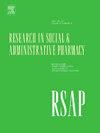采用德尔菲法编制并验证国家高危药物分类。
IF 3.7
3区 医学
Q1 PUBLIC, ENVIRONMENTAL & OCCUPATIONAL HEALTH
Research in Social & Administrative Pharmacy
Pub Date : 2025-02-01
DOI:10.1016/j.sapharm.2025.01.016
引用次数: 0
摘要
背景:高风险药物(HRMs)是指错误使用时对患者造成严重后果风险较高的药物。目的:本研究旨在制定芬兰高危药物分类(FIN-RiskMeds),以支持医疗保健专业人员进行人力资源管理风险管理。方法:FIN-RiskMeds由芬兰药品管理局(Fimea)采用德尔菲共识法协调开发。初步的人力资源管理清单是基于现有的人力资源管理清单、文献和工作组(WG)的专门知识的清单。通过三轮德尔菲调查(60名专家小组成员)和公开听证会,对分类内容达成共识。共识阈值设定为70%。结果:专家组同意将42种药物或药物类别(后面的“项目”)纳入fin - riskmedicines。在第一轮谈判中,双方就60项议题中的30项达成了70%的共识,在第二轮谈判中,双方就31项议题中的13项达成了70%的共识。最强烈的共识是华法林、甲氨蝶呤和阿片类药物。在第2b轮和第3轮之后,对所有项目的药物和用药过程的严重后果和主要风险进行了描述。根据工作组在公开听证会后的决定,最终分类包括38个项目。结论:本研究产生了基于专家共识的hrm分类和其主要风险的综合列表。应在整个卫生和社会保健领域确定人力资源管理机制及其风险,以防止潜在的用药错误。有必要制定用药流程,以尽量减少与hrm相关的风险。本文章由计算机程序翻译,如有差异,请以英文原文为准。
Development and validation of the national High-Risk Medicine Classification using the Delphi method
Background
High-risk medicines (HRMs) are medicines that have a higher risk of causing severe consequences for the patient when used in error.
Objective
This study aimed to develop a Finnish High-risk Medicine Classification (FIN-RiskMeds) to support healthcare professionals in HRM risk management.
Methods
The development of FIN-RiskMeds was coordinated by the Finnish Medicines Agency (Fimea) using the Delphi consensus method. The preliminary list of HRMs was based on an inventory of existing HRM lists, literature, and the expertise of the working group (WG). A three-round Delphi survey with 60 panelists and a public hearing were used to achieve consensus on the content of the classification. The consensus threshold was set at 70 %.
Results
The expert panel agreed on 42 medicines or medicine classes (later ‘items’) to be included in the FIN-RiskMeds. A 70 % consensus was reached on 30 out of 60 items in Round 1 and on 13 out of 31 items in Round 2a. The strongest consensus was reached for warfarin, methotrexate, and opioids. The serious consequences and key risks of medicines and the medication process were described for all items after Rounds 2b and 3. Based on the WG's decision after a public hearing, the final classification consists of 38 items.
Conclusion
This study produced expert consensus-based classifications of HRMs and a comprehensive list of their key risks. HRMs and their risks should be identified across health and social care to prevent potential medication errors. It is necessary to develop medication processes to minimize the risks associated with HRMs.
求助全文
通过发布文献求助,成功后即可免费获取论文全文。
去求助
来源期刊

Research in Social & Administrative Pharmacy
PUBLIC, ENVIRONMENTAL & OCCUPATIONAL HEALTH-
CiteScore
7.20
自引率
10.30%
发文量
225
审稿时长
47 days
期刊介绍:
Research in Social and Administrative Pharmacy (RSAP) is a quarterly publication featuring original scientific reports and comprehensive review articles in the social and administrative pharmaceutical sciences. Topics of interest include outcomes evaluation of products, programs, or services; pharmacoepidemiology; medication adherence; direct-to-consumer advertising of prescription medications; disease state management; health systems reform; drug marketing; medication distribution systems such as e-prescribing; web-based pharmaceutical/medical services; drug commerce and re-importation; and health professions workforce issues.
 求助内容:
求助内容: 应助结果提醒方式:
应助结果提醒方式:


